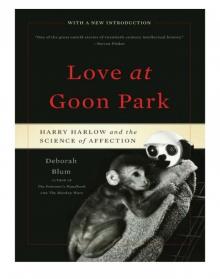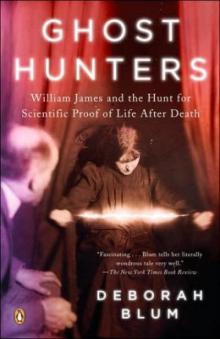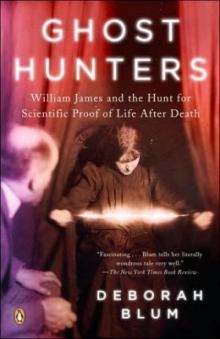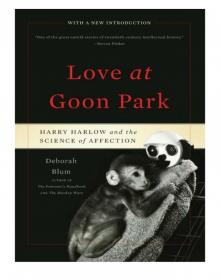- Home
- Deborah Blum
The Ghost Hunters
The Ghost Hunters Read online
Table of Contents
Title Page
Copyright Page
Dedication
Chapter 1 - THE NIGHT SIDE
Chapter 2 - A SPIRIT OF UNBELIEF
Chapter 3 - LIGHTS AND SHADOWS
Chapter 4 - METAPHYSICS AND METATROUSERS
Chapter 5 - INFINITE RATIONALITY
Chapter 6 - ALL YE WHO ENTER HERE
Chapter 7 - THE PRINCIPLES OF PSYCHOLOGY
Chapter 8 - THE INVENTION OF ECTOPLASM
Chapter 9 - THE UNEARTHLY ARCHIVE
Chapter 10 - A PROPHECY OF DEATH
Chapter 11 - A FORCE NOT GENERALLY RECOGNIZED
Chapter 12 - A GHOST STORY
Acknowledgements
NOTES AND SOURCES
INDEX
FOR THE BEST IN PAPERBACKS, LOOK FOR THE
PENGUIN BOOKS
GHOST HUNTERS
Deborah Blum is a professor of science journalism at the University of Wisconsin. She worked as a newspaper science writer for fifteen years, winning the Pulitzer Prize in 1992 for her writing about primate research, which she turned into a book, The Monkey Wars. Her other books include Sex on the Brain and Love at Goon Park. She has written about scientific research for the Los Angeles Times, The New York Times, Discover, Health, Psychology Today, and Mother Jones. She lives in Madison, Wisconsin, with her husband, two sons, and a very large boxer.
PENGUIN BOOKS
Published by the Penguin Group
Penguin Group (USA) Inc., 375 Hudson Street, New York, New York 10014, U.S.A.
Penguin Group (Canada), 90 Eglinton Avenue East, Suite 700, Toronto,
Ontario, Canada M4P 2Y3 (a division of Pearson Penguin Canada Inc.)
Penguin Books Ltd, 80 Strand, London WC2R ORL, England
Penguin Ireland, 25 St Stephen’s Green, Dublin 2, Ireland (a division of Penguin Books Ltd)
Penguin Group (Australia), 250 Camberwell Road, Camberwell,
Victoria 3124, Australia (a division of Pearson Australia Group Pry Ltd)
Penguin Books India Pvt Ltd, 11 Community Centre, Panchsheel Park, New Delhi - 110 017, India
Penguin Group (NZ), 67 Apollo Drive, Rosedale, North Shore 0745, Auckland,
New Zealand (a division of Pearson New Zealand Ltd)
Penguin Books (South Africa) (Pry) Ltd, 24 Sturdee Avenue, Rosebank, Johannesburg 2196, South Africa
Penguin Books Ltd, Registered Offices: 80 Strand, London WC2R ORL, England
First published in the United States of America by The Penguin Press,
a member of Penguin Group (USA) Inc. 2006
Published in Penguin Books 2007
Copyright © Deborah Blum, 2006
All rights reserved
Grateful acknowledgment is made for permission to reprint selections from the following works:
Materials in the archives of the American Society for Psychical Research, Richard Hodgson
Collection and James H. Hyslop Collection. Used by permissions of the American Society for
Psychical Research, Inc. (ASPR), New York, New York.
Letters of William James in the collection of the Houghton Library (bMS Am 1505 and
bMS Am 1938). By permission of the Houghton Library, Harvard University.
eISBN : 978-1-101-04253-3
1. James, William, 1842-1910. 2. Parapsychology—History—19th century.
3. Spiritualism—History—19th century. 4. Ghosts. I. Title.
BF1028.B57 2006
133.909’034—dc22 2006044948
The scanning, uploading and distribution of this book via the Internet or via any other means without the permission of the publisher is illegal and punishable by law Please purchase only authorized electronic editions, and do not participate in or encourage electronic piracy of copyrighted materials. Your support of the author’s rights is appreciated.
http://us.penguingroup.com
To the sisterhood-Darcy, Dawn, and Dana
PRELUDE
NO ONE SAW the girl die. It was just a little too early, a morning still too dark, first light barely warming the edge of the sky. The night frost yet shimmered on the ground, a faint ghostly silver. It was barely 6:00 a.m. on a late October morning when sixteen-year-old Bertha Huse stepped out into the quiet. Her parents and her sister were still asleep in the small house they shared in Enfield, New Hampshire.
Later, a few of the town folk, those like the blacksmith’s wife who were up doing morning chores, recalled seeing the girl go by, tying her bonnet as she went. She was a familiar sight, catching a quick walk before she started her mill job. The blacksmith’s wife watched Bertha turn toward the lake. She left a trail of footprints on the frosty dirt road, but they vanished as the sun climbed higher and warmer.
When their child didn’t come home, her parents were at first puzzled. Then a little worried. And slowly, as the sky lightened and the morning quickened, they became frantic. They were out calling for her, hunting down the empty road to the shores of the silent lake. As it became obvious that something was really wrong, their friends and neighbors joined in. By day’s end, the searchers numbered more than a hundred and fifty people, calling ever louder, rattling through empty thickets and fields, more and more of them glancing toward the polished blank of the water.
The dirt road led to an old Shaker bridge, a structure of wooden boards, without railings, offering a simple passage across Mascoma Lake. The lake was longer than wide, clear gold at its edges, darker at its center where the water deepened, shining like an agate set into the burnished hills. Around the bridge though, the water turned opaque, clotted with weeds growing around the wood, dropping to a black depth of eighteen feet. The searchers found no trace of the girl, not in the woods, in the clear shallows, or around the bridge where the water gleamed as a dark mirror, reflecting only the worried faces.
Finally, the mill owner himself sent for a diver from Boston to explore around the Shaker bridge. The diver, suited against the cold of the lake, slid down, disappearing himself like a stone beneath the surface. Again and again he tried, until his leather suit was sodden and his glass bubble helmet filmed with lake water. But he didn’t find the girl either. It was as if Bertha had vanished into the dawn itself. There was nothing—except the nightmare that caused a woman in a nearby town to start screaming in her sleep.
GEORGE AND NELLIE TITUS lived almost five miles away, down lake, in the mill town of Lebanon. Like Bertha, George worked in one of the clothing mills. The workers spread the tale of the lost girl. Everyone knew—and worried—about a missing child. The Tituses talked it over, wondered if they could help.
After supper, Nellie Titus went upstairs and curled into a rocking chair for a nap, pulling a blanket over herself She was asleep when her husband came up the stairs, but she was sitting almost bolt upright, her hands wringing in her lap and her breath coming in gasps. She screamed. Alarmed, he reached over and shook her awake. Her eyes stayed unfocused. But her voice came sharp and unhappy “Oh, George,” she said. “Why did you wake me?” A little deeper into the dream, she insisted, she could have told him where that girl was. He shook his head. It was a nightmare, he said, you were screaming. “Don’t wake me again,” she answered, almost pleading. “No matter what I do in my sleep.”
The dreams haunted them both for another day. Bertha Huse had disappeared on a Monday morning. That Thursday, George Titus gave up on sleep at 1:00 a.m. He lit a lamp and turned toward his wife. She was shivering now, teeth chattering. “Are you cold, Nellie?” he asked as he pulled the quilt up. “Oh, oh, I am awfully cold,” she answered, and then she slid silently down into the bed. When she woke, the dawn was once again breaking against the blackness of the night. We have to go to the Shaker bridge, she told her hus
band.
He was almost too exhausted to argue. And anyway, she was scaring him. Titus went to the stable where he kept a horse and told the stable master, almost casually, that his wife had dreamed the answer to the missing girl. The man laughed, but George Titus shook his head and recounted what she had told him. That Bertha Huse had first appeared on the bridge, hesitating about which way to go. She balanced on a frost-slick board, looking back toward the village. Her foot slipped, and she went backward into the lake. It was about at this point in the dream, he thought, that his wife had begun shaking with cold.
The Tituses drove their buggy onto the bridge. They were more than halfway before she asked to stop. Nellie Titus walked to the edge. “George,” she said, pointing down the bridge supports. “She is right there.” He could see nothing but the polished surface of the water, black and glossy as obsidian. He stared at his watery reflection. There was one other thing that he knew, which he hadn’t told his friend at the stable. Nellie was the grand-daughter of a known psychic. She didn’t claim to be one herself. But she’d had these haunted dreams before. They always left her physically ill. She hated them. They came anyway, slipping past her defenses as she slept.
The couple tracked down George Whitney, the mill manager, who was heading up the search team, and he—frustrated and desperate—called in the diver. The diver was a slim, wiry Irishman named Brian Sullivan. He thought they were all crazy. Sullivan worked for the Boston Tow-Boat Company, and he’d been diving for bodies for years. Bodies were sometimes hard to find, that’s all. That was reality. Dreams weren’t. Whitney told him that he didn’t believe in such dreams either. They were both rational men, he assured Sullivan; they both agreed that ghosts did not really creep into dreams.
But Whitney knew people in the village who were less “rational.” There were those who did believe in visiting spirits. And he told Sullivan, “As long as we have started to do all we could to recover the body, we ought to at least give this woman a chance.”
Sullivan continued arguing. He wanted to send to Boston for blasting powder and set off an explosion that would shake the girl’s body loose from the lake bottom, if it was there. He told Whitney that he was willing to take orders—but he did not want make a fool of himself, splashing in and out of the lake while Mrs. Titus spouted mystical nonsense and pointed at assorted dream spots. Whitney conceded the point. He had no intention of looking ridiculous either. They would give her one chance only.
Nellie Titus walked on the bridge again and stood where the horse had first stopped. She shook her head. No, she said, not quite right. She walked a few more feet and leaned forward a little, staring down into the lake. “Here,” she said. And she told the diver that the girl was wedged upside down in the wooden structure of the bridge, but that one foot was sticking up, still in its rubber overshoe.
Sullivan put on his dive suit and dropped a guideline, tied to a sinker, down into the water. The lake was so dark that once underwater, he could see nothing. He slid down ten feet into the black of the water, feeling his way down the bridge structure. Something bumped his face. He fumbled to feel it. It was a foot. His hand slid over the rubber boot and down a leg, and he began to pull. He tied the guideline round the body and scrambled up to give the news.
“She’s here,” he shouted as his head, monsterlike in its glass bubble, broke the surface.
Whitney shouted back, “I know.”
Even before Sullivan freed the body, the girl’s bonnet had tugged loose, floating upward until it hung just below the surface, like a sodden flower.
Later, at the inn tavern in Lebanon, Sullivan told his story to a fascinated crowd. Wasn’t he afraid, someone asked, when he was down there in the pitch-black with the girl’s body bumping his face? No, he answered. “It is my business to recover bodies in the water, and I am not afraid of them.” But he feared something else—or rather, someone else. He was unnerved by how precisely Nellie Titus had described the location of the body. They wouldn’t have found it without her, he said; he couldn’t even see the body when he was floating next to it. What power did she have that a dead girl walked in her dreams? “In this instance, I was afraid of the woman on the bridge.”
The woman on the bridge drew another audience, one that saw much more than a fearful oddity. Her story was investigated and then published by a surprisingly elite group of scientists and philosophers. They viewed it as evidence, a data point in an ambitious—and professionally risky—scientific endeavor to prove the existence of life after death.
One philosopher, a supporter of the endeavor, recalled being given a very direct warning against the effort, having a colleague direct his attention to a “once eminent chemist” with the comment that the man “had been a brilliant scientist but that recently he had unfortunately gone off his head” and begun investigating the supernatural. And yet investigating the supernatural—using the techniques of science to explore the occult—was exactly what William James and his friends wanted to do, in fact, considered a necessary part of science and its mission to understand the world. It was James who wrote up the story of the drowned girl for publication, neatly sifting the evidence for answers. His report cited interviews with everyone from the Boston diver to George Titus, from the mill owner to the blacksmith’s wife. In his conclusion, James ruled out fraud, any chance that Mrs. Titus had been lurking around the lake in the frosty dawn. He ruled out any relationship at all between the dead girl and the woman who helped find her. His report included the diver’s first reaction—“I was stunned”—and the Huse family’s baffled gratitude for help from a stranger with a “God-given power.”
Like the once-acclaimed chemist, William James had a reputation to lose. He was a heralded professor at Harvard University, the author of the most respected text on psychology yet published, a founder of the American Psychological Association. He’d developed an innovative approach to philosophy, rattling elitist traditions by linking everyday, real-life experience to intellectual exploration. He’d become famous even beyond academic circles, almost as well known as his novelist brother, Henry James Jr. The timing, in terms of personal credibility, was absolutely terrible. He said what he thought anyway: “My own view of the Titus case consequently is that it is a decidedly solid document in favor of the admission of a supernormal faculty of seership.”
James and his companions in this scientific ghost hunt were famed for their intellectual brilliance—their intellectual courage gained them less admiration. Yet they possessed both qualities in abundance. James’s fellow ghost hunters included the codiscoverer of the theory of evolution, a physiologist from France who would win the Nobel Prize in Medicine, an Australian who became a founding member of the American Anthropological Society, a female mathematician who became principal of Cambridge University’s first college for women, a pioneer in British utilitarian philosophy, and a trio of respected physicists.,
All of them had reputations that would suffer as a consequence, and all of them, like William James, would refuse to abandon the search. For all the risks, the work had its rewards as well—participating in what would become the best ghost hunt in the history of science, conducting studies that would frequently startle and sometimes convert skeptics into believers. All of them believed that they were working toward an understanding of life that could help bridge the chasms between science and faith, between what people see and what they imagine.
“Hardly, as yet, has the surface of the facts called ‘psychic’ begun to be scratched for scientific purposes. It is through following these facts, I am persuaded, that the greatest scientific conquests of the coming generation will be achieved,” James would write. The requirements for achieving that goal were both simple and almost impossibly complex. They included patience, a belief in infinite possibilities—and a willingness to accept that a dead girl could rise, as ephemeral and as real as mist, above the black lake of a dream.
1
THE NIGHT SIDE
WILLIAM JAMES sensed his o
wn life growing short that year of Nellie Titus’s haunted dreams, having celebrated his fifty-sixth birthday the previous January. His cropped dark hair and short beard were rimmed with gray. Smile lines radiated like sunbursts around his eyes. But his eyes remained sharply blue, his body wiry and compact, and his movements still hummed with the intensity of his youth.
James had never been a physically imposing man. He stood just five feet eight inches tall, fine-boned, and high-strung. As a young medical student, with a barely suppressed preference for art, he’d sketched himself as a dreamer—sharp cheekbones, sensitive mouth, flowing hair, drooping mustache, shadowed eyes. Over the years, he’d shed the soft look but not the inner, idiosyncratic dreamer. He found upright Victorian tailoring uncomfortable, preferring to dress in tweed jackets with checked trousers, soft shirts, and thick, cushioned shoes. To the end, he found predictability dull, once complaining that spending time with one of his more methodical Harvard colleagues was “like being in the dentist’s chair.”
Arguing with a fellow researcher about the importance of the paranormal, James coolly reminded his colleague that science—the nineteenth-century powerhouse behind the electric light and the dynamo, the telegraph and the telephone—could be both arrogant and wrong. James wrote to Science magazine, a journal devoted to upholding the research ethic, that he loathed the reverential use of the word “scientist ... it suggests to me the priggish, sectarian view of science, as something against religion, against sentiment,” even against real-life experience.
His approach kept him often at odds with the views of his academic colleagues, whom he sometimes referred to as the “orthodoxers.” But unorthodoxy came to him naturally. He’d grown up in an almost dazzlingly unstable household, and he recognized, intuitively, the cultural instability of his times. The era was one of intense moral imbalance—religion apparently under siege from science, technology seemingly rewriting the laws of reality. Finding some balance, a way to make sense of existence in the changing world, seemed to him an imperative.

 Love at Goon Park: Harry Harlow and the Science of Affection
Love at Goon Park: Harry Harlow and the Science of Affection The Poison Squad
The Poison Squad Ghost Hunters: The Victorians and the Hunt for Proof of Life After Death
Ghost Hunters: The Victorians and the Hunt for Proof of Life After Death The Poisoner's Handbook
The Poisoner's Handbook Angel Killer
Angel Killer The Best American Science and Nature Writing 2014
The Best American Science and Nature Writing 2014 The Ghost Hunters
The Ghost Hunters Love at Goon Park
Love at Goon Park